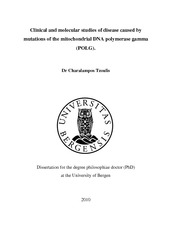| dc.contributor.author | Tzoulis, Charalampos | en_US |
| dc.date.accessioned | 2011-01-06T12:42:14Z | |
| dc.date.available | 2011-01-06T12:42:14Z | |
| dc.date.issued | 2010-11-26 | eng |
| dc.identifier.isbn | 978-82-308-1651-6 (print version) | en_US |
| dc.identifier.uri | https://hdl.handle.net/1956/4403 | |
| dc.description.abstract | Background: Mutations in the gene encoding the DNA-polymerase gamma (POLG), the enzyme that replicates and repairs the mitochondrial genome, are an important cause of human disease and disability. Over 130 pathogenic mutations have been reported and these produce a wide spectrum of disease that mainly includes syndromes with myopathy or/and encephalopathy. Aims: To define the clinical features, natural history, pathophysiology and molecular pathogenesis of POLG-disease focusing particularly on disease caused by the mutations c.1399G>A, p.A467T and c.2243G>C, p.W748S, but including other POLG mutations causing encephalopathic disorders such as Alpers’ syndrome. Patients and methods: The studies presented herein were performed on a large group of patients (n=42) with POLG-disease comprising 36 with juvenile/adult encephalopathy, 4 with infantile encephalopathy and 2 with progressive external ophthalmoplegia (PEO). Patients were categorized according to genotype and clinical features and studied by a variety of clinical, pathological and molecular methods. Studies included thorough clinical evaluation and follow-up, clinical and electrophysiological investigation of the epilepsy, imaging methods comprising conventional magnetic resonance imaging (MRI), diffusion imaging (DWI) and magnetic resonance spectroscopy (MRS), postmortem histological and histochemical examination and molecular studies of mitochondrial DNA in biopsy and post-mortem tissues. Results and conclusions: The common POLG mutations, A467T and W748S, caused a clinically well-defined entity usually presenting in the mid-teens (mean 15.2 years, range 1.5-45) and characterised by progressive spinocerebellar ataxia, encephalopathy, neuropathy, migraine-like headache, myoclonus and late-onset external ophthalmoplegia. Most of our patients developed epilepsy, either at onset or during the course of their disease, and these experienced acute episodic exacerbations with rapidly progressive encephalopathy and expanding stroke-like cerebral lesions. Episode mortality was high (~50%) and in addition, several others suffered from valproate induced liver toxicity. MSCAE showed a complex epileptic semiology including a variety of clinical seizure types and frequent status epilepticus. Epilepsia partialis continua and an occipital epileptogenic focus on EEG were characteristic findings and should provide a clue for the diagnosis. The prognosis of MSCAE depended on the genotype. Patients who were compound heterozygous (A467T/W748S) had a significantly (p=0.003) worse prognosis than homozygous patients with significantly lower life expectancy. We found that MRI is a sensitive detector of disease activity in POLGencephalopathy. Typical findings included high T2 signal lesions in the thalamus, cerebellar white matter and olivary nuclei. During exacerbation episodes both MSCAE and Alpers’ patients commonly developed stroke-like cortical lesions which had a predilection for the posterior brain and showed restricted diffusion and lactate accumulation in the acute phase. Stroke-like lesions evolved dynamically mirroring clinical progression of the episode and their course had prognostic significance. Histology of affected cortical and deep CNS areas revealed selective neuronal loss, eosinophilic necrosis and laminar cortical necrosis. Histochemistry showed reduced or absent cytochrome oxidase (COX) activity in some neurons, but was normal in blood vessels. MtDNA studies revealed tissue-specific depletion and multiple deletions. The findings of mtDNA damage and histochemical COX deficiency suggest that POLG mutations lead to secondary dysfunction of the respiratory chain, which is predicted to cause energy failure due to ATP deficiency. We present here findings suggesting that regional chronic energy failure indeed occurs in the CNS of patients with POLGencephalopathy. Moreover, acute episodic energy crisis may occur, which appears to be triggered and/or sustained by epileptic seizures. | en_US |
| dc.language.iso | eng | eng |
| dc.publisher | The University of Bergen | eng |
| dc.relation.haspart | Paper I: Brain 129(7), Tzoulis C.; Engelsen, B. A.; Telstad, W.; Aasly, J.; Zeviani, M.; Winterthun, S.; Ferrari, G.; Aarseth, J. H.; Bindoff, L. A., The spectrum of clinical disease caused by the A467T and W748S POLG mutations: a study of 26 cases, pp. 1685-1692. Copyright 2006 the Author. Published by Oxford University Press on behalf of the Guarantors of Brain. Full text not available in BORA due to publisher restrictions. The published version is available at: <a href="http://dx.doi.org/10.1093/brain/awl097" target="_blank"> http://dx.doi.org/10.1093/brain/awl097</a> | en_US |
| dc.relation.haspart | Paper II: Brain 131(3), Engelsen, B. A.; Tzoulis, C.; Karlsen, B.; Lillebø, A.; Lægreid, L. M.; Aasly, J.; Zeviani, M.; Bindoff, L. A., POLG1 mutations cause a syndromic epilepsy with occipital lobe predilection, pp. 818-828. Copyright 2008 the Author. Published by Oxford University Press on behalf of the Guarantors of Brain. Full text not available in BORA due to publisher restrictions. The published version is available at: <a href="http://dx.doi.org/10.1093/brain/awn007" target="_blank">http://dx.doi.org/10.1093/brain/awn007</a> | en_US |
| dc.relation.haspart | Paper III: Brain 133(5), Tzoulis, C.; Neckelmann, G.; Mørk, S. J.; Engelsen, B. A.; Viscomi, C.; Moen, G.; Ersland, L.; Zeviani, M.; Bindoff, L. A., Localized cerebral energy failure in DNA polymerase gamma-associated encephalopathy syndromes, pp. 1428-1437. Copyright 2010 the Author. Published by Oxford University Press on behalf of the Guarantors of Brain. Full text not available in BORA due to publisher restrictions. The published version is available at: <a href="http://dx.doi.org/10.1093/brain/awq067" target="_blank"> http://dx.doi.org/10.1093/brain/awq067</a> | en_US |
| dc.relation.haspart | Paper IV: Acta Neurologica Scandinavica 120(Supplement s189), Tzoulis, C.; Papingji, M.; Fiskestrand, T.; Røste, L. S.; Bindoff, L. A., Mitochondrial DNA depletion in progressive external ophthalmoplegia caused by POLG1 mutations, pp. 38-41. Copyright 2009 John Wiley & Sons. Full text not available in BORA due to publisher restrictions. The published version is available at: <a href="http://dx.doi.org/10.1111/j.1600-0404.2009.01212.x" target="_blank"> http://dx.doi.org/10.1111/j.1600-0404.2009.01212.x</a> | en_US |
| dc.title | Clinical and molecular studies of disease caused by mutations of the mitochondrial DNA polymerase gamma (POLG). | en_US |
| dc.type | Doctoral thesis | |
| dc.rights.holder | Copyright the author. All rights reserved | |
| dc.rights.holder | The author | |
| dc.subject.nsi | VDP::Medisinske Fag: 700::Klinisk medisinske fag: 750::Nevrologi: 752 | nob |
